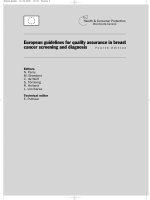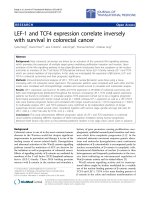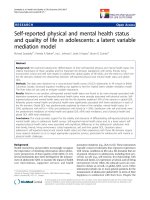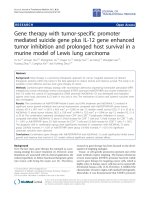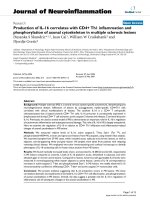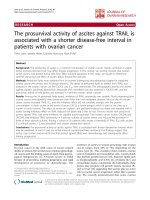AKAP3 correlates with triple negative status and disease free survival in breast cancer
Bạn đang xem bản rút gọn của tài liệu. Xem và tải ngay bản đầy đủ của tài liệu tại đây (561.87 KB, 7 trang )
Esmaeili et al. BMC Cancer (2015) 15:681
DOI 10.1186/s12885-015-1668-0
RESEARCH ARTICLE
Open Access
AKAP3 correlates with triple negative status
and disease free survival in breast cancer
Rezvan Esmaeili1, Keivan Majidzadeh-A1,2*, Leila Farahmand1, Maryam Ghasemi2, Malihe Salehi1
and Ali Reza Khoshdel3
Abstract
Background: Cancer-testis antigens are among the new promising biomarkers, especially for targeted therapy.
Aberrant and specific expression of these proteins has been reported in some tumor tissues. Also understanding
their differential role in normal and cancer tissues may introduce them as new candidates for biomarker in cancer.
Methods: AKAP3 expression was investigated in 162 tumors, normal adjacent and normal tissues of the breast with
Real-Time PCR. Also the correlation between the gene expression and clinico-pathologic features of the tumors and
treatment regimen was evaluated.
Results: There was an association between lack of AKAP3 expression in tumor tissues and triple negative status
(p=. 03). There was also a correlation between lack of this marker and tumor size (p = .01) and stage (p = .04). Lack
of AKAP3 in normal adjacent tissues was associated with poor prognosis. Kaplan Meier plot demonstrated a
remarkable better 5-year disease free survival in AKAP3 positive normal adjacent group.
Conclusions: It was found that this relationship is originated from the difference in AKAP3 expression, not therapy
distribution between two groups of patients. Thus, it may be a proper biomarker candidate for triple negative
breast cancer patients. Also, testing AKAP3 in normal tissue of the patients may be used to predict the outcome of
the treatment.
Background
Among women, breast cancer is the most prevalent cancer and also one of the leading causes of cancer mortality. Biomarkers are the most useful tools for prevention
and better management of the disease. Although the biomarker discovery has led to a great deal of results in
many aspects of cancer, there are still many challenging
issues in this area which cause biomarker discovery to
be still underway. Moreover triple negative breast cancer
(TNBC) as a more aggressive and poor prognosis breast
cancer is still an important clinical challenge.
Cancer-testis antigens (CTA) are among the new
promising biomarkers, especially for targeted therapy
[1]. They are members of a group of proteins which are
normally expressed in testis and to a lesser extent in
* Correspondence:
1
Cancer Genetics Department, Breast Cancer Research Center, ACECR, No
146, South Gandhi Ave, Vanak Sq., Tehran, Iran
2
Tasnim Biotechnology Research Center (TBRC), School of Medicine, AJA
University of Medical Sciences, Tehran, Iran
Full list of author information is available at the end of the article
ovarian germ cells [2, 3]. Since the aberrant and specific
expression of these biomarkers has been reported in
some tumor tissues, they may act as new candidates for
targeted therapy [4]. Also understanding their differential role in normal and cancer tissues may emerge new
predictive or prognostic biomarkers. Therefore the study
of the expression pattern of these biomarkers and its relationship to clinical features of the patients are subjects
of great interest.
A-kinase anchoring proteins (AKAP) are a group of
CTA which play important roles in sperm function and
are classified based on their ability of binding to c-AMP
dependent protein kinase A (PKA) II. AKAP encoded
proteins are localized in the fibrous sheath of sperm and
may act as regulators of its motility, capacitation and acrosome reaction [5].
AKAP3 is a member of AKAP proteins that was reported to be expressed in epithelial ovary cancer. AKAP3
expression was found to be a significant predictor of both
overall and progression-free survival in patients with
poorly differentiated ovary tumors [6].
© 2015 Esmaeili et al. Open Access This article is distributed under the terms of the Creative Commons Attribution 4.0
International License ( which permits unrestricted use, distribution, and
reproduction in any medium, provided you give appropriate credit to the original author(s) and the source, provide a link to
the Creative Commons license, and indicate if changes were made. The Creative Commons Public Domain Dedication waiver
( applies to the data made available in this article, unless otherwise stated.
Esmaeili et al. BMC Cancer (2015) 15:681
In this study, we aimed to determine if there is a specific expression of AKAP3 in tumor compared to normal
tissue. Based on this specific expression, this marker can
be a candidate to use as prognostic, predictive or even
as a candidate for targeted therapy. To test this potency,
the presence of AKAP3 mRNA was investigated in invasive ductal carcinoma (IDC) of breast comparing to
adjacent normal and normal tissues. Also the correlation between the gene expression and clinico-pathologic
features of the tumors and treatment regimen was
evaluated.
Material & methods
Samples
A total of 162 breast tissue samples including 74 tumor,
73 normal adjacent, 15 normal breast tissues were taken
from the Breast Cancer Research Center Biobank
(BCRC-BB) [7]. Two breast cancer cell lines (MCF7 and
T47D) (taken from Avicenna infertility clinic (AIC))
were included in the study. To check the probability of
AKAP3 expression in breast tumor cells, its expression
was checked first in these two cell line then it was
assayed in tumor, normal and normal adjacent tissues
using Normal testis tissue as a positive control. According to the protocols followed by BCRC-BB, after excisional biopsy or surgery the content of cancer cells in
each sample was pathologically checked and immediately
sample tissues were snap-frozen in liquid nitrogen and
stored at −70 °C. BCRC-BB is obliged to ethical guidelines and recommendations for biobanks on the storage
and use of human biological samples. Also, all patients
provided written informed consent before entering the
biobank. This study was approved by the Ethics Committee of the BCRC before conducting the project. The
Clinical and histopathological features of patients along
with treatment regimen were gathered. Patient’s status
was defined based on the occurrence of any event like
recurrence, metastasis or death due to cancer in their
follow-up history. Patients who had these events are categorized as poor prognosis group. Patients were categorized in treatment subgroups according their treatment
status as follows: CMF (cyclophosphamide, methotrexate
and 5-fluorouracil) regimen and anthracycline and/or
taxane-containing regimen with or without endocrine
therapy and finally endocrine therapy only.
Real-Time PCR
RNA extraction and cDNA synthesis were done as previously explained [8]. Primers for AKAP3 and Actin Beta
(ACTB) which was designed by Gene Runner v.3.05 and
confirmed with primer express 3.0.are as follows:
AKAP3 F: CAGGACTGGAAAATGGACACCT, AKAP3
R: TTTGTGTGGGTCTCCTGAGTTG. ACTB F: CAGC
Page 2 of 7
AGATGTGGATCAGCAAG, ACTB R: GCATTTGCG
GTGGACGAT
To check the presence of AKAP3 mRNA, Real Time
PCR was carried out using SYBR Green PCR Master
Mix (PrimerDesign Ltd, UK). Primer concentration was
0.5 μM for both genes. ACTB was detected to confirm
cDNA quality. Fluorescent detection was performed
using Applied Biosystems 7500 System. To ensure the
formation of specific amplicon, first the size of the PCR
product was checked on agarose electrophoresis and was
sequenced using Big Dye terminator DNA sequencing
(Applied Biosystems, Foster City, CA) (data not shown),
then each reaction was followed by melting curve analysis involving heating of the PCR product from 60 to
95 °C. The curve in the specimens was compared with
curve of positive control to recognize specific amplicon
from primer dimer formation. The melt point of 83.4 °C
was defined for AKAP3 amplicon. Reactions with this
melting point were considered positive for AKAP3 expression. Any amplicon with other melt point was regarded as
nonspecific amplification. Data were analyzed using SDS
software, vers.2.0 (Applied Biosystems).
Data analysis
Patients were categorized based on their type of tumor,
according to ER, PR and Her2/neu status. Moreover
AKAP3 expression was analyzed in each type of tumor,
including triple negative group and the remaining types
including ER/PR + Her2/neu -, ER/PR- Her2/neu + and
ER/PR/ Her2/neu +. Different combinations of these
groups were used for data analysis.
All statistical analyses were performed with the SPSS
statistical software (vers.18). The relationship between the
presence of AKAP3 expression and clinico-pathological
data and treatment regimen were analyzed using nonparametric tests. Patient disease free survival was assessed by
Kaplan-Meier analysis using log-rank tests. The P value of
<0.05 was considered as significant results. All the plots
were performed using Graph Pad Prism 3.02 (GraphPad
Software, San Diego, Calif).
Results
Study population
Clinico-pathological characteristics of the study population are presented in Table 1. The median age of the
samples was 48 (range: 29–87 years). Median duration
of follow up was 35 (1–65 months). The percentage of
patients with stage 1 to 4 is 10, 48, 30 and 12 correspondingly. 31 % of patients had an event like recurrence,
metastasis or death due to cancer in their follow-up history while 69 % didn’t show any event and 4 patients
had no available event data. ER, PR and Her2/neu positivity were 44, 35 and 31% respectively. The most frequent treatment subgroup was anthracycline and/or
Esmaeili et al. BMC Cancer (2015) 15:681
Page 3 of 7
Table 1 Patient’s characteristics and AKAP3 status. Stage grouping
are based on American Joint Committee on Cancer (AJCC),
Estrogen receptor (ER), progesterone receptor (PR), Her2/neu are
based on IHC results. Cut point of positivity is based on American
Society of Clinical Oncology (ASCO) guideline for IHC
Number of patients
74
Age (median/range) — year
48 (29–87)
Follow-up (median/range)—month
1 8 (1–38)
Valid percent
ER status (2 missing, n = 74)
Negative
40
55
Positive
32
45
PR (2 missing, n = 74)
Negative
47
65
Positive
25
35
Negative
50
69
Positive
22
31
G1
6
9
G2
34
51
G3
27
40
Her2/neu status (2 missing, n = 74)
Grade (7 missing, n = 74)
Patient status (3 missing, n = 74)
healthy survival
50
70
with events
21
30
I
7
10
II
33
48
III
21
30
IV
8
12
<=2
24
35
>2
44
65
Negative
47
64
Positive
27
36
Stage (5 missing, n = 74)
Tumor Size (6 missing, n = 74)
AKAP3 Tumor (n = 74)
AKAP3 Normal adjacent (n = 73)
Negative
40
56
Positive
32
44
Negative
8
54
Positive
7
46
Akap3 Normal Breast (n = 15)
taxane-containing regimen with endocrine which was
44% (data not shown).
Expression of AKAP3 mRNA
Two breast cancer cell lines expressed AKAP3 mRNA.
AKAP3 expression was seen in normal testis tissue
which serves as a positive control, 36.5 % of tumors,
43.2 % of normal adjacent and 46.6 % of normal breast
tissues, while Actin Beta was expressed in all the
samples.
The McNemar’s test revealed no difference in distribution of AKAP3 expression between tumor and normal
adjacent tissues. The relationship between AKAP3 expression and ER, PR and Her2/neu status was analyzed
in tumor and normal adjacent tissues separately. There
was a significant association between lack of AKAP3
expression in tumor tissues and triple negative status
(p=. 03) and there was no correlation with the remaining
types including ER/PR + Her2/neu -, ER/PR- Her2/neu
+ and ER/PR/ Her2/neu +. AKAP3 negativity is a real
absence of this gene and it is not based on specific cut
point. To check if this difference originates from AKAP3
expression or from treatment regimen, the association
between AKAP3 expression in tumor tissues and treatment regimen was investigated and no association was
seen.
There was a significant association between lack of
AKAP3 in normal adjacent tissue and poor prognosis
(p = .003). It means that patients with AKAP3 expression in normal adjacent tumor (28/63 of the patients)
were associated with only 4/28 events compared to
an event rate of 13/35 in the AKAP3 negative group.
Kaplan Meier plot demonstrated a remarkable better
survival in AKAP3 positive normal adjacent group,
that was statistically significant in log-rank analysis
(P = .03) (Fig. 1). The follow-up for both groups were
comparable (P = .2). There was not such a relationship
with the AKAP3 expression in tumor tissues (P = .8).
To find if this significance result originated from
triple negative status as a poor prognosis subtype or
it is from lack of AKAP3 expression in normal adjacent, we analyzed the relationship of AKAP3 in normal adjacent tissues and prognosis in the triple
negative group compared to other types. This association was not correlated with the triple negative
group. In other words, the relationship between lack
of AKAP3 expression in normal adjacent and poorer
outcome is significantly detectable in the other subtypes of breast cancer than triple negative breast cancer (p = .01). The analysis between AKAP3 expression
in normal adjacent tissues and treatment regimen
didn't show any significant results (Fig. 2). Chi-square
analysis showed a significant relationship between the
expression of AKAP3 in tumor tissues and tumor size
(p=. 01) and stage (p=. 04). Based on these analyses,
AKAP3 expression in tumor tissues was diminished
in tumor size above 2 cm. Also the proportion of patients in stage one who expressed AKAP3 in their
tumor tissues was more than other stages. Same analysis with grade, number of positive lymph nodes and
Esmaeili et al. BMC Cancer (2015) 15:681
Page 4 of 7
Figure 1 AKAP3 expression in tumor and normal adjacent tissue of the breast. a-c Represent AKAP3 expression in tumor (AKAP3T) and
clinico-pathological features. Significant results were seen in stage, subtype and tumor size. d-f Show AKAP3 expression in normal adjacent tissue
(AKAP3N) and clinico-pathological features. Significant result was seen in the event which represents prognosis
Esmaeili et al. BMC Cancer (2015) 15:681
Page 5 of 7
Figure 2 Kaplan Meier plot. Kaplan Meier plot of patient survival stratified by AKAP3 expression in tumor (right) and normal adjacent (left) tissues.
Vertical tick marks represent censored patients. Censoring means the total survival time for that patient cannot be accurately determined. Most of
the time occurs when participants either drop out of the study or refuse to participate in the study
the age of diagnosis of the patients did not show any
significant results (Table 2).
Discussion
Looking for genes that are specifically expressed in cancer tissues and have a limited expression in normal tissues is one of the most important targets of researchers
in the field of cancer treatment. Among these targets,
CTAs could be a promising option and there are a lot of
researches in this field [1, 2, 7–9]. In this study expression of AKAP3 were investigated in tumor, normal adjacent and normal tissue of the breast in association with
clinical features of the patients.
AKAP3 is classified as one of the members of scaffold
proteins (AKAPs). They are a family of about 50 scaffolding proteins which anchor protein kinase A (PKA) II
and other proteins including protein kinases, protein
phosphatases and phosphodiesterases. So they can specify intracellular locations and restrict the corresponding
enzymatic activities [10, 11]. As a result of multi-protein
complexes which are formed by these anchoring proteins, cAMP signaling is integrated with other pathways
[5]. Such a compartmentalization represents the critical
roles of AKAPs in cellular activities. Accordingly subtle
changes in the AKAPs related pathways or their components is an explanation of the development of many diseases, especially cancer [12].
Triple negative breast cancer is still poorly characterized at the molecular level and Lack of prognostic
markers and selective targets of therapy make it the
most aggressive type of breast cancer which deserves
more investigation [13, 14]. In the current study AKAP3
expression is deficient significantly in triple negative tumors. CAMP-dependent protein kinase is usually
present in tissues as a mixture of type I and type II isozyme and changing their ratio involved in the oncogenic
process. The PKAII is mostly present in normal tissues,
whereas its isoform PKAI which is not related to AKAPs
is expressed in malignant tissues [15]. Since AKAP3 is a
scaffold for binding of PKAII, lack of AKAP3 expression
which is seen in this study may be due to the absence or
decreased level of PKAII in malignant tissues. Although
this could be the reason of absence of AKAP3 expression in malignant tissue, we still don’t know whether the
hormone independence status in triple negative tissues
affects this status or not. If this protein have eligibility to
use as prognostic factor in triple negative patient require
further investigation. Based on this study, AKAP3 expression decreased significantly while tumors increased
in size and stage. This may be due to the association of
PKAII with inhibition of mitogenic signaling and cell
growth [16]. Moreover, since PKA signaling with different AKAPs may direct cell toward proliferation or death,
AKAP3 may act as an inhibitor of proliferation signals
[17]. But, further study need to decide about this suggestion because down regulated genes are not always involved in inhibition of proliferation.
Based on the results, the patients with lack of AKAP3
in their normal adjacent tissues represent the poorer
outcome. The analysis between expression of this gene
and different treatment subtypes revealed no significant
results which may show that the significant differences
in patient survival, found in this study, would be originated from the difference in AKAP3 expression not
therapy distribution between two groups of patients. In
the previous study by Sharma s et al., AKAP3 expression
correlated with poor prognosis in epithelial ovarian cancer [6], but its expression was not explored in normal
adjacent tissue. Alteration in gene expression of histologically normal adjacent tissue is a matter of debate. A
number of studies suggested that morphologically normal tissue adjacent to carcinomas has not undergone
significant gene expression changes when compared to
normal tissue [18]. In contrast, some evidence suggests
Esmaeili et al. BMC Cancer (2015) 15:681
Page 6 of 7
Table 2 AKAP3 expression and clinico-pathologic data. Statistical association between clinico-pathologic data and AKAP3 expression
in tumor and normal adjacent tissue
Variable
AKAP3 expression
p value
In tumor
AKAP3 expression
p value
In normal
Negative no (%)
Positive no (%)
Negative
27 (67.5)
13 (32.5)
Positive
20 (62.5)
12 (37.5)
Negative no (%)
Positive no (%)
21 (55.3)
17 (44.7)
17 (53.1)
15 (46.9)
ER
0.4
0.5
PR
Negative
30 (63.8)
17 (36.2)
Positive
17 (68)
8 (32)
Negative
34 (68)
16 (32)
Positive
13 (59.1)
9 (40.9)
0.4
24 (53.3)
21 (46.7)
14 (56)
11 (44)
25 (51)
24 (49)
13 (61.9)
8 (38.1)
0.5
Her2
0.3
0.2
Tumor Grade
1
3 (50)
3 (50)
3 (50)
3 (50)
2
21 (61.8)
13 (38.2)
0.7
18 (52.9)
16 (47.1)
3
18 (66.7)
9 (33.3)
14 (56)
11 (44)
No
15 (68.2)
7 (31.8)
1-3
13 (56.5)
10 (43.5)
4-9
8 (57.1)
6 (42.9)
9 (75)
3 (25)
>9
7 (70)
3 (30)
6 (60)
4 (40)
≤2cm
10 (41.7)
14 (58.3)
13 (54.2)
11 (45.8)
>2 cm
32 (72.7)
12 (27.3)
23 (54.8)
19 (45.2)
0.9
Lymph Node
0.7
10 (45.5)
12 (54.5)
11 (47.8)
12 (52.2)
0.3
Tumor size
0.01
0.5
Stage
I
1 (14.3)
6 (85.7)
II
22 (66.7)
11 (33.3)
0.04
2 (28.6)
5 (71.4)
16 (48.5)
17 (51.5)
III
14 (66.7)
7 (33.3)
12 (63.2)
7 (36.8)
IV
6 (75)
2 (25)
6 (75)
2 (25)
Triple Negative
20 (80)
5 (20)
13 (54.2)
11 (45.8)
Other types
27 (56.3)
21 (43.8)
26 (55.3)
21 (44.7)
No event
31 (63.3)
18 (36.7)
19 (41.3)
27 (58.7)
With event
14 (66.7)
7 (33.3)
16 (80)
4 (20)
0.2
Subtype
0.03
0.5
Patient status
that these tissues represent modifications in molecular
level resembling tumor tissues [19]. These alterations
can reveal the earliest changes leading to tumorigenesis
or may due to the effect of the tumor. In two studies in
prostate cancer, microarray comparison of tumor, normal adjacent and normal tissue revealed up- regulation
of transcription factors, signal transducers and growth
regulatory genes in tumor and normal adjacent but normal tissues [20, 21]. In 2006 Schneiders et al., suggested
0.5
0.003
that the genetic profile of the normal adjacent tissue
may be associated with treatment failure in rectal cancer,
suggesting the importance of the tumor microenvironment in the development of recurrence of rectal tumors
[22]. Since recurrence is a significant clinical problem
for patients with cancer, having the possibility of genetic
assessment in normal material of patients in predicting
the recurrence is of great interest in medical research.
More research on AKAP3 on easily accessible tissues of
Esmaeili et al. BMC Cancer (2015) 15:681
the patients could help to decide whether it is possible
to use normal material of the patients to predict the outcome of the treatment.
Conclusion
In conclusion, between the variety of biomarkers candidates, CTAs are promising genes among which AKAPs
draw much attention. Based on the results, AKAP3 may
be a proper candidate for further investigation as a biomarker for triple negative status. AKAP3 may act as inhibitor of proliferation since it was not expressed in
higher stage and tumor size. Moreover, our findings warrant complementary experiments, especially in protein
level to define the value of AKAP3 testing in normal tissue of patients as a marker of response to treatment.
Page 7 of 7
7.
8.
9.
10.
11.
12.
13.
14.
15.
Abbreviations
AKAP: A-kinase anchoring proteins; TNBC: Triple negative breast cancer;
CTA: Cancer-testis antigens; PKA: Protein kinase A; IDC: Invasive ductal
carcinoma; BCRC-BB: Breast Cancer Research Center Biobank;
CMF: Cyclophosphamide, methotrexate and 5-fluorouracil; ER: Estrogen
receptor; PR: Progesterone receptor; IHC: Immunohistochemistry;
ASCO: American Society of Clinical Oncology.
Competing interests
All other authors declare that they have no conflict of interests in this
research. The authors alone are responsible for the content and writing of
the paper.
16.
17.
18.
19.
Authors’ contributions
RE designed the project, was responsible for data analysis and writing the
manuscript. MG and LF performed the experiments. MS was in charge with
clinical data. AKH was critically reviewed data analysis and statistics parts. KM
conceived and designed the project and critically reviewed data analysis and
manuscript. All authors read and approved the final manuscript.
20.
Acknowledgements
The authors would like to acknowledge the Breast Cancer Research Center
(BCRC) and AJA University of Medical Science for financial support.
22.
Author details
1
Cancer Genetics Department, Breast Cancer Research Center, ACECR, No
146, South Gandhi Ave, Vanak Sq., Tehran, Iran. 2Tasnim Biotechnology
Research Center (TBRC), School of Medicine, AJA University of Medical
Sciences, Tehran, Iran. 3Department of epidemiology, School of Medicine, Aja
University of Medical Science, Tehran, Iran.
21.
Okada T, Akada M, Fujita T, Iwata T, Goto Y, Kido K, et al. A novel cancer
testis antigen that is frequently expressed in pancreatic, lung, and
endometrial cancers. Clin Cancer Res. 2006;12(1):191–7.
Taylor M, Bolton LM, Johnson P, Elliott T, Murray N. Breast cancer is a
promising target for vaccination using cancer-testis antigens known to elicit
immune responses. Breast Cancer Res. 2007;9(4):R46.
Curigliano G, Viale G, Ghioni M, Jungbluth A, Bagnardi V, Spagnoli G, et al.
Cancer–testis antigen expression in triple-negative breast cancer. Ann
Oncol. 2011;22(1):98–103.
Hundsrucker C, Klussmann E. Direct AKAP-mediated protein-protein
interactions as potential drug targets. Handb Exp Pharmacol.
2008;186:483–503.
Tröger J, Moutty MC, Skroblin P, Klussmann E. A-kinase anchoring proteins
as potential drug targets. Br J Pharmacol. 2012;166(2):420–33.
Cohen P. The development and therapeutic potential of protein kinase
inhibitors. Curr Opin Chem Biol. 1999;3(4):459–65.
Bernardi R, Gianni L. Hallmarks of triple negative breast cancer emerging at
last? Cell Res. 2014;24(8):904–5.
Carey LA. Directed therapy of subtypes of triple-negative breast cancer.
Oncologist. 2011;16 Suppl 1:71–8.
Cho-Chung YS, Pepe S, Clair T, Budillon AO, Nesterova M. cAMP-dependent
protein kinase: role in normal and malignant growth. Crit Rev Oncol
Hematol. 1995;21(1–3):33–61.
Tortora G, Ciardiello F. Targeting of epidermal growth factor receptor and
protein kinase A: molecular basis and therapeutic applications. Ann Oncol.
2000;11(7):777–83.
Hedrick ED, Agarwal E, Leiphrakpam PD, Haferbier KL, Brattain MG,
Chowdhury S. Differential PKA activation and AKAP association determines
cell fate in cancer cells. J Mol Signal. 2013;8(1):10.
Finak G, Sadekova S, Pepin F, Hallett M, Meterissian S, Halwani F, et al. Gene
expression signatures of morphologically normal breast tissue identify
basal-like tumors. Breast Cancer Res. 2006;8(5):R58.
Forsti A, Louhelainen J, Soderberg M, Wijkstrom H, Hemminki K. Loss of
heterozygosity in tumour-adjacent normal tissue of breast and bladder
cancer. Eur J Cancer. 2001;37(11):1372–80.
Haaland CM, Heaphy CM, Butler KS, Fischer EG, Griffith JK, Bisoffi M.
Differential gene expression in tumor adjacent histologically normal
prostatic tissue indicates field cancerization. Int J Oncol. 2009;35(3):537–46.
Chandran UR, Dhir R, Ma C, Michalopoulos G, Becich M, Gilbertson J.
Differences in gene expression in prostate cancer, normal appearing
prostate tissue adjacent to cancer and prostate tissue from cancer free
organ donors. BMC Cancer. 2005;5:45.
Schneider S, Park DJ, Yang D, El-Khoueiry A, Sherrod A, Groshen S, et al.
Gene expression in tumor-adjacent normal tissue is associated with
recurrence in patients with rectal cancer treated with adjuvant
chemoradiation. Pharmacogenet Genomics. 2006;16(8):555–63.
510.1097/1001.fpc.0000220563.0000244724.0000220566d.
Received: 21 October 2014 Accepted: 1 October 2015
References
1. Scudellari M. A ballsy search for cancer targets. Nat Med. 2011;17(8):916–8.
2. Chen Y-T, Scanlan MJ, Sahin U, Türeci Ö, Gure AO, Tsang S, et al. A testicular
antigen aberrantly expressed in human cancers detected by autologous
antibody screening. Proc Natl Acad Sci. 1997;94(5):1914–8.
3. Scanlan MJ, Simpson AJ, Old LJ. The cancer/testis genes: review,
standardization, and commentary. Cancer Immun. 2004;4:1.
4. Suri A, Saini S, Sinha A, Agarwal S, Verma A, Parashar D, et al. Cancer testis
antigens: A new paradigm for cancer therapy. Oncoimmunology.
2012;1(7):1194–6.
5. Carnegie GK, Means CK, Scott JD. A-kinase anchoring proteins: from protein
complexes to physiology and disease. IUBMB Life. 2009;61(4):394–406.
6. Sharma S, Qian F, Keitz B, Driscoll D, Scanlan MJ, Skipper J, et al. A-kinase
anchoring protein 3 messenger RNA expression correlates with poor
prognosis in epithelial ovarian cancer. Gynecol Oncol. 2005;99(1):183–8.
Submit your next manuscript to BioMed Central
and take full advantage of:
• Convenient online submission
• Thorough peer review
• No space constraints or color figure charges
• Immediate publication on acceptance
• Inclusion in PubMed, CAS, Scopus and Google Scholar
• Research which is freely available for redistribution
Submit your manuscript at
www.biomedcentral.com/submit
